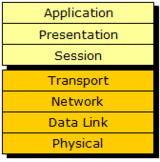The Open Systems Interconnection (OSI) reference model has been an essential element of computer network design since its ratification in 1984. The OSI is an abstract model of how network protocols and equipment should communicate and work together (interoperate).
The OSI model is a technology standard maintained by the International Standards Organization (ISO). Although today's technologies do not fully conform to the standard, it remains a useful introduction to the study of network architecture.
The OSI Model Stack
The OSI model divides the complex task of computer-to-computer communications, traditionally calledinternetworking, into a series of stages known aslayers. Layers in the OSI model are ordered from lowest level to highest. Together, these layers comprise the OSI stack. The stack contains seven layers in two groups:
Upper layers -
7. application
6. presentation
5. session
Lower layers -
4. transport
3. network
2. data link
1. physical
Upper Layers of the OSI Model
OSI designates the application, presentation, and session stages of the stack as the upper layers. Generally speaking, software in these layers performs application-specific functions like data formatting, encryption, and connection management. Examples of upper layer technologies in the OSI model are HTTP, SSL and NFS.
Lower Layers of the OSI Model
The remaining lower layers of the OSI model provide more primitive network-specific functions like routing, addressing, and flow control. Examples of lower layer technologies in the OSI model are TCP, IP, and Ethernet.
Benefits of the OSI Model
By separating the network communications into logical smaller pieces, the OSI model simplifies how network protocols are designed. The OSI model was designed to ensure different types of equipment (such as network adapters, hubs, and routers) would all be compatible even if built by different manufacturers. A product from one network equipment vendor that implements OSI Layer 2 functionality, for example, will be much more likely to interoperate with another vendor's OSI Layer 3 product because both vendors are following the same model.
The OSI model also makes network designs more extensible as new protocols and other network services are generally easier to add to a layered architecture than to a monolithic one.

No comments:
Post a Comment